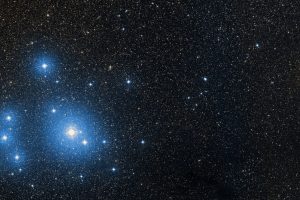A young Saturnian planet orbiting a star in the stellar cluster IC 2602 described in the study: “TOI-837 b: Characterisation, formation, and evolutionary history of an infant warm Saturn-mass planet” of M. Damasso (INAF – OATo)

Analysis of TESS and HARPS observations confirms the existence of a Saturn-like planet orbiting a star associated with the young stellar cluster IC 2602
Stellar clusters are not only beautiful objects to photograph and observe through a telescope, but they also represent an important opportunity for studying stellar evolution. In fact, they are composed of rich samples of stars of different types but similar ages, whose physical properties can be estimated through targeted observations and comparison with theoretical models.
In theory, this could also apply to exoplanet research—particularly in young stellar clusters where it might be possible to observe planets in formation or in still-young planetary systems. However, the search and characterization of exoplanets in these environments presents significant observational challenges. Stellar clusters typically have very crowded star fields, which makes it difficult to study the temporal variability of stellar emission—an essential element in detecting exoplanets via the transit technique. Moreover, young stars are characterized by intense magnetic activity, which interferes with the spectroscopic signals used to detect and analyze exoplanets.
For these reasons, it is no surprise that confirmed planets around young stars spark considerable interest within the scientific community. A research team led by astrophysicist M. Damasso (INAF – Astrophysical Observatory of Turin) recently analyzed observations obtained from NASA’s TESS satellite and the HARPS spectrograph, installed on the La Silla telescope at the European Southern Observatory, to study an exoplanet orbiting the star TOI-837, which belongs to the young stellar cluster IC 2602 (35 million years old). The analysis confirmed the existence of the planet and allowed for an estimate of its physical properties, which are similar to those of Saturn.
Based on the observations and models of planetary formation and migration, the researchers suggest different possible internal composition for the planet, among which the possibility that it has a massive core (with a mass between 40 and 80 Earth masses) and a thick atmosphere that makes up between 30% and 60% of the planet’s total mass, as recently suggested by an indepentend study of astronomers of the Oxford University. The atmospheric mass loss caused by incident stellar radiation (i.e., through “photoevaporation”) appears to be rather limited, with the current estimated rate being just a few thousandths of an Earth mass per million years. The study also suggested the presence of a companion star to TOI-837, indicating that the system is likely a binary.
The article, titled “TOI-837 b: Characterisation, formation, and evolutionary history of an infant warm Saturn-mass planet“, was recently published in Astronomy & Astrophysics and lists among its co-authors astrophysicists D. Locci, A. Maggio, and S. Benatti of INAF – Astronomical Observatory of Palermo.
The cover image (click here to view it in full) shows a DSS2 image of the stellar cluster IC 2602. The position of TOI-837 is marked with a yellow circle.
Mario Giuseppe Guarcello
Follow MarioSpiegaCose on Instagram () , Facebook (), Youtube (), and X ()
Follow the Astronomical Observatory of Palermo on Facebok and on Instagram
Subscribe the Youtube channel of the Astronomical Observatory of Palermo
